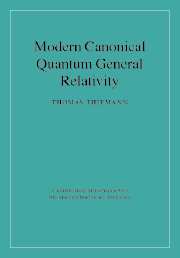Book contents
- Frontmatter
- Contents
- Foreword, by Chris Isham
- Preface
- Notation and conventions
- Introduction: Defining quantum gravity
- I CLASSICAL FOUNDATIONS, INTERPRETATION AND THE CANONICAL QUANTISATION PROGRAMME
- 1 Classical Hamiltonian formulation of General Relativity
- 2 The problem of time, locality and the interpretation of quantum mechanics
- 3 The programme of canonical quantisation
- 4 The new canonical variables of Ashtekar for General Relativity
- II FOUNDATIONS OF MODERN CANONICAL QUANTUM GENERAL RELATIVITY
- III PHYSICAL APPLICATIONS
- IV MATHEMATICAL TOOLS AND THEIR CONNECTION TO PHYSICS
- References
- Index
1 - Classical Hamiltonian formulation of General Relativity
Published online by Cambridge University Press: 04 August 2010
- Frontmatter
- Contents
- Foreword, by Chris Isham
- Preface
- Notation and conventions
- Introduction: Defining quantum gravity
- I CLASSICAL FOUNDATIONS, INTERPRETATION AND THE CANONICAL QUANTISATION PROGRAMME
- 1 Classical Hamiltonian formulation of General Relativity
- 2 The problem of time, locality and the interpretation of quantum mechanics
- 3 The programme of canonical quantisation
- 4 The new canonical variables of Ashtekar for General Relativity
- II FOUNDATIONS OF MODERN CANONICAL QUANTUM GENERAL RELATIVITY
- III PHYSICAL APPLICATIONS
- IV MATHEMATICAL TOOLS AND THEIR CONNECTION TO PHYSICS
- References
- Index
Summary
In this chapter we provide a self-contained exposition of the classical Hamiltonian formulation of General Relativity. It is mandatory to know all the details of this classical work as it lays the ground for the interpretation of the theory, the understanding of the problem of time and its implication for the interpretation of quantum mechanics, the meaning of observables, the relation between spacetime diffeomorphisms and gauge transformations and finally (Poincaré) symmetries versus gauge transformations. It also defines the platform on which the quantum theory is based. Only a solid knowledge of topology and differential geometry is necessary for this chapter, of which we give an account in Chapters 18 and 19.
The ADM action
The contents of this section were developed by Arnowitt et al. [206]. Modern treatments can be found in the beautiful textbooks by Wald [207] (especially appendix E and chapter 10) and by Hawking and Ellis [208]. We will treat only the vacuum case. Matter and cosmological terms can be treated the same way.
What we are going to do in what follows seems to be a dangerous enterprise in a generally covariant theory: we will split the spacetime manifold into space and time. While this is necessary in a canonical approach, as otherwise we cannot define velocities and hence momenta conjugate to the configuration variables, this seems to break diffeomorphism invariance. However, this is not the case because we do not fix the split into space and time, rather we keep it arbitrary, we do not fix a coordinate system. The arbitrariness in fact exhausts the full diffeomorphism group.
- Type
- Chapter
- Information
- Modern Canonical Quantum General Relativity , pp. 39 - 73Publisher: Cambridge University PressPrint publication year: 2007

